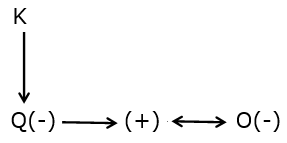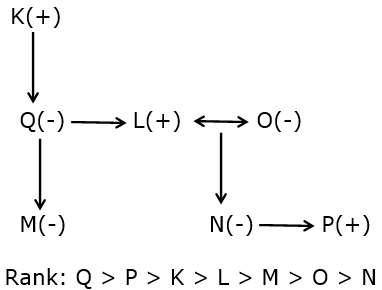Question
How Q is related to the one who got rank
4? Study the following information carefully and answer the given questions. Seven persons – K, L, M, N, O, P, and Q from a family of three generations participated in a painting competition and got different ranks from 1 to 7 where ‘1’ is the highest rank and ‘7’ is the lowest rank. No two persons got the same rank. Only one person got lower rank than K’s daughter-in-law. Q is the sister-in-law of O and vice-versa. Q is the only daughter of K. O doesn’t have any siblings. K got higher rank than both L and M but not as much as P, who didn’t get the highest rank. N is the only daughter of L, who got three ranks higher than N. Q is the paternal aunt of P, who got immediate lower rank than Q. Q’s daughter got immediate higher rank than L’s wife. L is not married to K. The gender of K and M is not same.Solution
Only one person got lower rank than K’s daughter-in-law.
Q is the sister-in-law of O and vice-versa.
Q is the only daughter of K.
O doesn’t have any siblings.
That means, O must be daughter-in-law of K.
K got higher rank than both L and M but not as much as P, who didn’t get the highest rank.
Based on the above given information we have: For Ranking:
For Ranking:
__ P > K > L, M
Again, we have:
N is the only daughter of L, who got three ranks higher than N.
Q is the paternal aunt of P, who got immediate lower rank than Q.
From the above given statement we have:
Q > P > K > L, M
Again, we have:
Q’s daughter got immediate higher rank than L’s wife.
L is not married to K.
That means, L must be married to O.
Since, M is the only remaining person, thus M must be daughter of Q.
The gender of K and M is not same.
Thus, K must be the father of Q.
Based on the above given information we have:
Q is related to the sister got rank 4
- A total of Rs. ‘K’ was to be distributed among L, M, and N in ratio of 2:5:3 respectively but due to some reason the money was falsely distributed in r...
The ratio of two numbers is 5:11. If each number is decreased by 2, the ratio becomes 4:9. Find the smaller numbers.
In an office, the ratio of the number of males to number of females is 9:4. If 2 males joined the class and 8 females left the class, then the ratio of ...
- Find the fourth proportion of (2k - 5), (k + 1), and (3k + 4). (Note: 'k' is the smallest two-digit prime number.)
A person distributes Rs. 61,600 among 11 men, 13 women and 3 children. If each woman receives four times as much as each children and each man receives ...
Total population of city P and Q is 3360 and 4850 respectively. If the ratio of number of males to females in city is P and Q is 5:3 and 3:2 respectivel...
A sum of money is divided among P, Q, R and S in the ratio of 3:4:8:9 respectively. If the share of R's is Rs. 2600 more than the share of Q, then what ...
A box contains the coins of 5p, 10p and 25p are in the ratio 3:4:6. If there is Rs. 164 in all, how many 10p coins are there?
90 percent of first number is equal to 40 percent of the second number. What is the respective ratio of the first number to the second number?
A seller sold three types of fruits i.e. apples, bananas, and oranges. The number of apples sold is 30% of the total number of fruits sold, and the rati...


